|
Harry "The Hipster" Gibson
|
|
|
|
Harry Gibson (b. Harry Raab, 1915, d. 1991) was rocking
and rolling, decades before Elvis. His 15 minutes of fame were during the mid-40's, after which he drifted into obscurity, only to be
rediscovered during the 1970's. He was a genius at the piano,
master of boogie woogie, Dixieland, bop, blues, classical, ragtime, stride,
Bach, and styles of his own. He sang of subjects that got his records banned from radio
stations...drugs, adultery,
drinking, murder, and frantic freaks, but he maintained a cult
of devout followers. Almost all of his recordings were his own compositions,
most were unusual and brilliant.
We are now building a database of his song lyrics.
|
|
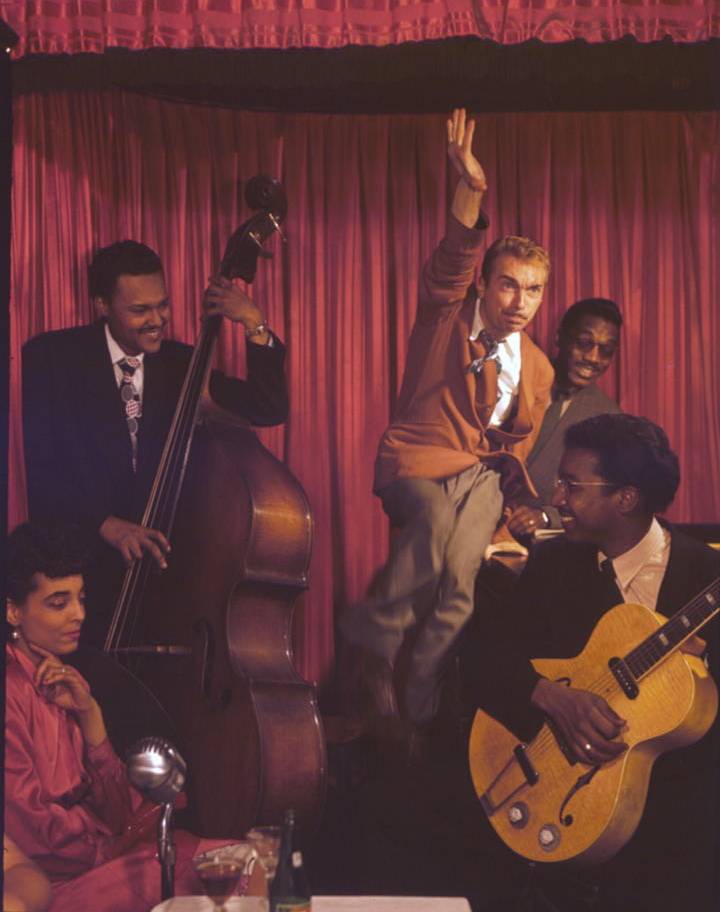 |
|
Harry started playing piano as a child in the Bronx, New York
City, and in the 1920's was playing in Dixieland jazz bands in
the South Bronx and Harlem. During
prohibition he already knew most of
the songs of his favorite jazz pianists, and was invited into
black speakeasies in Harlem as a teenager to play piano. After
repeal, in 1933, he was regularly playing in Harlem nightclubs.
He played tunes by the great stride pianists of the day, but his
favorite was Fats Waller. He was basically a Fats Waller jukebox in his early days. Word got around Harlem that there was a
skinny blond-haired Jewish kid playing Fats Waller songs, and
playing them note for note, in all the clubs. Word got back to
the man himself who, in 1939, came into the club, pretended to
be a customer, to watch the kid play, requesting his own
songs and sticking fat $5 bills in the kitty after each one.
After Harry proved what he could do, Waller finally introduced
himself, and hired him on the spot as his
intermission pianist
on Swing Street, (52nd St between 5th and 7th Ave, which was the
Mecca of jazz at the time).
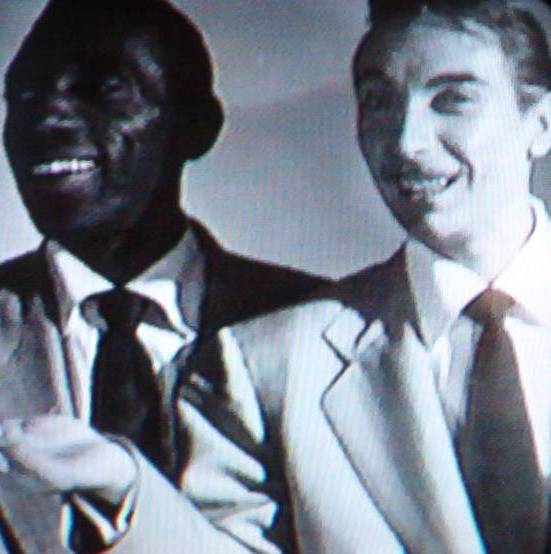 |
|
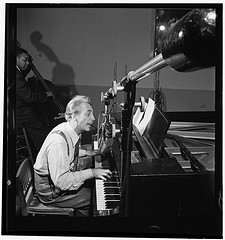 .
Billed as Harry Raab before then, on Swing Street he took his
show-biz name "Gibson" off a gin
bottle. But Harry Gibson still needed a nickname. At the time, jazz musicians
were using the words "hep" and "hepcat," but too many
squares were beginning to use those words, so some people started saying "hip"
instead. Gibson
coined the word "hipster" and started addressing his audience that way.
"Gather round, all you hipsters," he would say from the piano. Fellow musicians
picked up on the new word and began to kid him about it, calling him "The Hipster." The
name stuck, especially after he wrote the song "Handsome Harry, The Hipster," in
the early 40's, and recorded it in 1944. From 1939 to 1945 he worked full-time on
"Swing Street," playing with Charlie Parker, Dizzy Gillespie,
Billy Holliday, Art Tatum, and all the rest of the pioneers of
bebop who congregated there. At the same time he studied at
Juilliard, the prestigious music academy, and became a fellow in
their graduate school. But he quit that to concentrate on jazz,
and started writing his own songs. .
Billed as Harry Raab before then, on Swing Street he took his
show-biz name "Gibson" off a gin
bottle. But Harry Gibson still needed a nickname. At the time, jazz musicians
were using the words "hep" and "hepcat," but too many
squares were beginning to use those words, so some people started saying "hip"
instead. Gibson
coined the word "hipster" and started addressing his audience that way.
"Gather round, all you hipsters," he would say from the piano. Fellow musicians
picked up on the new word and began to kid him about it, calling him "The Hipster." The
name stuck, especially after he wrote the song "Handsome Harry, The Hipster," in
the early 40's, and recorded it in 1944. From 1939 to 1945 he worked full-time on
"Swing Street," playing with Charlie Parker, Dizzy Gillespie,
Billy Holliday, Art Tatum, and all the rest of the pioneers of
bebop who congregated there. At the same time he studied at
Juilliard, the prestigious music academy, and became a fellow in
their graduate school. But he quit that to concentrate on jazz,
and started writing his own songs. |
|
His first album was 1944's "Boogie Woogie in
Blue," an album of 78 RPM records (4 records, 8
sides) of boogie, blues, and jive. This album got him exposure and led to an
invitation to Billy Bergs jazz club in Hollywood in 1945, where he went on live radio and recorded
V-Discs and 4 more sides for Musicraft,
including his notorious piece about the Murphy family. The next year he did the
movie "Junior Prom," and a play with Mae West. His recording "Who Put
The Benzedrine in Mrs. Murphy's Ovaltine" got him banned from radio stations and
blacklisted from the music industry in 1947, and he dropped off the
face of the earth, until popping up in the late-1970's as the leader of a rock and
roll band called "The Rock Boogie Blues Jammers," still calling himself
"The Hipster."
He did jail time on drug charges in the 40's, and when rock and roll arrived in the
50's, nobody wanted to hear older jazz musicians, so he drove a taxi and became a
recluse. His
comeback in the late 70's and 80's showed him as an eccentric, white-haired, gravel-voiced
man playing hard rock, boogie woogie, and ragtime, in modern rock bands made up
of musicians 40 and 50 years his junior. The two albums he released in the late-80's are gems, full of
comical songs praising drug use,
blowing any chance that his records will ever be sold in
Wal-Mart. For example, a song he recorded in 1989
about a little grass shack in Hawaii made of Maui Wowie, that can be smoked as
needed, replanted from the seeds, and rebuilt from the stems and leaves.
Unlike his 1940's contemporaries, who
continued to play the same music for decades, (if they survived), Harry
changed to fit the times, which is why he was the Hipster. |
|
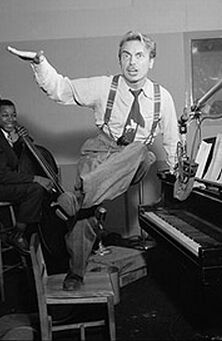 |
His debut album "Boogie Woogie In Blue," 1944.
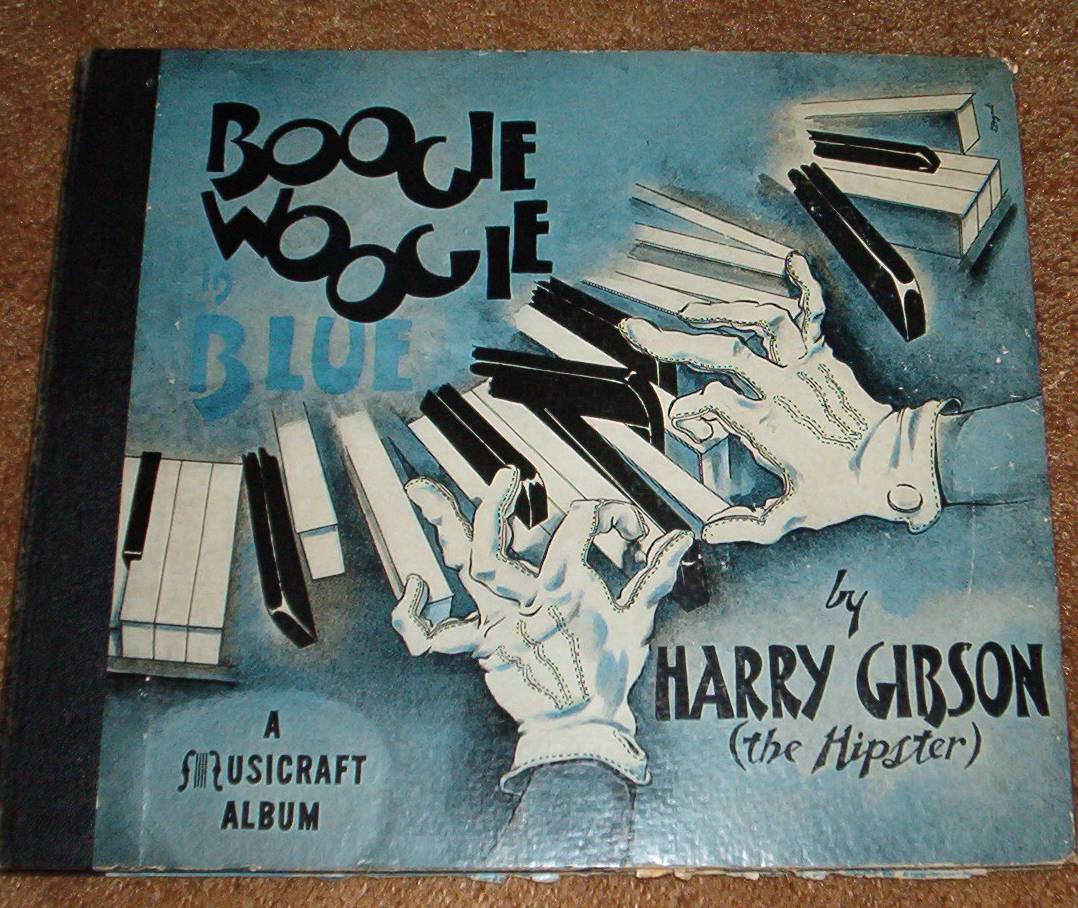
His second album, "The Hipster," 1947.
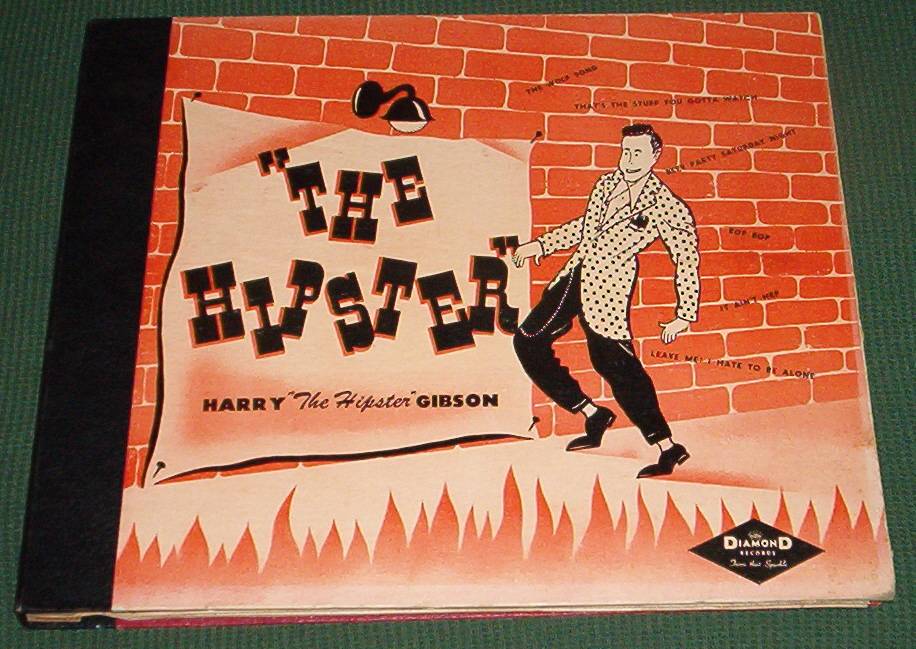
But most impressive are the
"soundies" he did in NYC, which contain
footage of probably the first white guy to play
and sing in a rock and roll style, with slicked back
hair, unrestrained wild singing...and this was 10 years before Elvis ever set foot in a
record studio. All 3 of his soundies were filmed in April, 1944. Before this,
piano players, even the hard-rocking boogie pioneers like Pete Johnson and
Albert Ammons, were sitting upright and playing like gentlemen. But these films show The Hipster, stomping at the piano and
standing on the bench to rock the 88's, 10 years before Little Richard or Jerry Lee Lewis. As you watch them, you have to keep reminding yourself that this
is really 1944 footage and that this is not rock and roll of the 1950's. The only thing different, if this were the 1950's, is
that he would be wearing blue jeans and a white tee shirt instead of a
zoot suit, but musically, it's the 1950's in 1944. Far from being a primitive
version of rock and roll piano, Harry's music came out of the slick jazz world, and his
musicianship was superior to the clumsy piano smashing of
Jerry Lee Lewis or others in the 50's, but he rocks just as hard if not harder. His high
level of musicianship shows that his teachers were the greats such as Fats Waller and
many of the other top Harlem pianists. This is really amazing stuff!
1. Opus 12 EEE
Release date December 18, 1944. Rocking like Jerry Lee Lewis, 12 years earlier.
2. 4F Ferdinand The Frantic Freak
Release date Aug. 7, 1944. Rock and roll.
Below is the inside cover
of the 1944 album "Boogie Woogie in Blue" which contains several
rockers if you have a 78 RPM player in your house.
Click here for zooms of it.
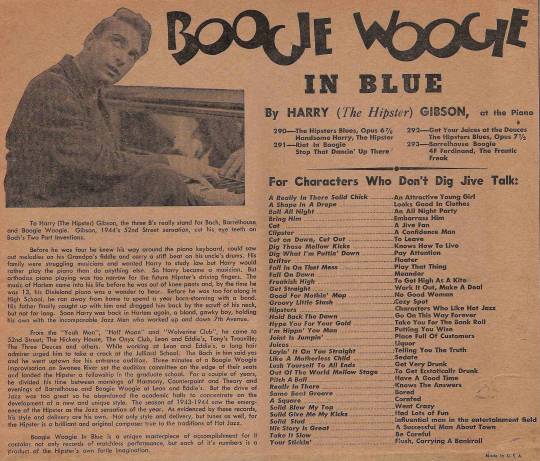

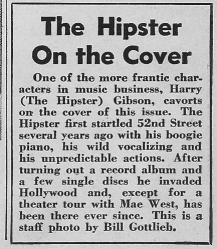
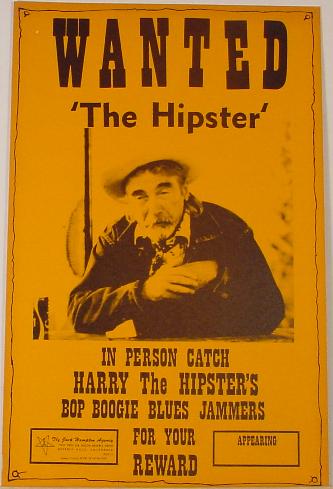 Harry the senior citizen hipster
in the 1980's
Harry the senior citizen hipster
in the 1980's
More links:
http://www.artistdirect.com/nad/music/artist/listenwatch/0,,435465,00.html#artist_name
Hipography
(records only, does not include radio transcriptions or Euro-bootlegs of
existing recordings)
"BOOGIE WOOGIE IN BLUE,"
album of 4 singles (8 sides), Musicraft
Records, album 64
5169 HANDSOME HARRY, THE HIPSTER -MUSICRAFT 290
5170 BARRELHOUSE BOOGIE -MUSICRAFT 293
5171 RIOT IN BOOGIE -MUSICRAFT 291
5172 STOP THAT DANCIN' UP THERE -MUSICRAFT 291
5173 4F FERDINAND THE FRANTIC FREAK -MUSICRAFT 293
5174 GET YOUR JUICES AT THE DEUCES -MUSICRAFT 292
5175 THE HIPSTER'S BLUES, OPUS 6 7/8 -MUSICRAFT 290
5176 THE HIPSTER'S BLUES, OPUS 7 1/2 -MUSICRAFT 292
(April 21, 1944,
NYC). John Simmons, bass; Sid Catlett,
skins.
STOP THAT DANCING UP THERE
/ PUT A NICKEL IN THE SLOT -V-DISC
200 side a
STOP THAT DANCING UP THERE
/ PUT A NICKEL IN THE SLOT -V-DISC
420 side a
(Jan, 1945) Note: V Discs 200a and 420a were pressed from the same master.
Although matrix numbers differ, audition clearly shows they are the same take.
YOU CAN SAY THAT AGAIN /
ZOOT GIBSON STRIDES AGAIN -V-DISC 492
side a
(1945, Jack Lesberg, bass; Johnny Blowers, drums; Sgt. George Jaffe, trumpet)
5351 I STAY BROWN ALL YEAR 'ROUND
-MUSICRAFT 346
5349 WHO PUT THE BENZEDRINE IN MRS. MURPHY'S OVALTINE? -MUSICRAFT
346
5350 WHO'S GOIN' STEADY WITH WHO? -MUSICRAFT 347
5352 WHAT'S HIS STORY? -MUSICRAFT 347
(Feb 8, 1946, Radio Recorders, Los Angeles. CA). Slim Gaillard, axe;
Tiny Brown, bass; Zutty Singleton, skins
"The
Hipster," album of 3 singles (6 sides), Diamond Records, album D9
THE WOLF SONG -DIAMOND 2065
THAT'S THE STUFF YOU GOTTA WATCH -DIAMOND 2065
BOP BOP -DIAMOND 2066
BEER PARTY SATURDAY NIGHT -DIAMOND 2066
IT AIN'T HEP -DIAMOND 2067
LEAVE ME! I HATE TO BE ALONE -DIAMOND 2067
(Feb. 12 & 13, 1947, NYC) Al Hall, bass; Morey Feld,
skins.
[note: songwriting credit for all 6 of these songs went to one Irvin Rose. It
was common in those days for record label owners to claim songwriting credits
for themselves, usually under a pseudonym, so they could avoid paying royalties.
Diamond was owned by Irving R. Gwirtz. We can be sure Harry wrote them!]
I Hope My Mother-in-Law Doesn't Come for Christmas -MACGREGOR 902
THE GAMBLER'S SONG
-MACGREGOR 902
THE BABY AND THE PUP -MACGREGOR 903
The Worm Song
-MACGREGOR 903
(1947) Note: 902 issued on 78, reissued in 1951 as 1021 on 78
and 45 RPM. 903 issued on 78, reissued in 1951
as 1022 on 78 and 45 RPM.
SF2191
GOLDILOCKS AND THE 3 BEARS -ALADDIN 3199
SF2192 TWO CATS (not issued)
(July 31, 1953, San Francisco, CA)
RR2189-5 CITY MOUSE AND COUNTRY MOUSE
-INTRO 6082
RR2190-2 JACK AND THE BEANSTALK -ALADDIN 3199
(August 3, 1953, Los Angeles, CA)
RR2193-1 CINDERELLA (not issued)
RR2194-1 SNOW WHITE -INTRO 6082
(August 7, 1953, Los Angeles, CA)
I'M GOING TO SIT RIGHT DOWN AND
WRITE MYSELF A LETTER -HIP
501
Live Fast
Die Young Have A Good Looking Corpse -HIP 501
(1957.)
"DIG
HARRY THE HIPSTER" -Hip 502 (EP with 4 tracks)
1. Live Fast
Die Young Have A Good Looking Corpse -HIP 502
2. Be My Guest -HIP 502
3. Gotta Way With Women -HIP
502
4. Dixie Preacher Man
-HIP 502
(George Bledsoe,
bass, LeRoy McCrae, drums)
(1957).
Hip Records was owned by Harry, and possibly co-owned by Lord Buckley.
ROCKIN' RHYTHM
-SUTTON 313
CAUTION, BOOTLEG
(This is a 1950's or 60's bootleg LP containing 3 of the 1944 Musicraft sides dubbed from
scratchy 78's, and 5 other songs that are not Harry at all. Avoid this
shameless bootleg).
HIPSTER'S BOOGIE -MILE
101
INFLATIONARY
BLUES - MILE 101
(1974, Spectrum Studios, Venice, CA.) 45 RPM single. Both tracks reissued on
Progressive LP in 1986, see below.
KEEP VENICE NUDE -MILE
102
PUTZI PUTZI
- MILE 102
(1974, Spectrum Studios, Venice, CA.) 45 RPM single. Both tracks reissued on
Progressive LP in 1986, see below.
"HARRY THE HIPSTER DIGS CHRISTMAS"
-TOTEM 1023
(1976) LP album of new recordings, re-released 1994 on CD by Viper's Nest, VN 153
THAT'S THE SPIRIT
-TOTEM 101
WHO'S GOING
STEADY WITH WHO? -TOTEM 101
(1976) 45 RPM single. Both tracks later added to 1994 CD reissue of "Harry
The Hipster Digs Christmas" on Viper's Nest
"EVERYBODY'S CRAZY BUT ME"
-PROGRESSIVE PRO 7042 (for LP) and PCD 7042 (for the CD)
(Released 1986) album of new recordings, at least 4 of which were recorded in
1974 (Mile 101 and 102). CD re-release, 1999, as PRCD 7042
1. HIPSTERS BOOGIE
2. INFLATIONARY BLUES
3. WILD HIP RAP
4. SOLUTION FOR POLLUTION
5. HOMEGROWN
6. MOCHA
1. STOP THAT DANCING UP THERE
2. KEEP VENICE NUDE
3. PUTSI PUTSI
4. MALE CHAUVINISTIC PIG
5. RAGTIME RAGGEDY ANN
"WHO PUT THE BENZEDRINE IN MRS.
MURPHY'S OVALTINE" -DELMARK DE-687 (CD
album, 1989, includes 10 new recordings and 6 tracks from a 1976 live show.)
1. HEY MAN, YOU JUST MADE MY DAY
2. I GOT FRAMED
3. I WANNA GO BACK TO MY LITTLE GRASS SHACK
4. WHO PUT THE BENZEDRINE IN MRS. MURPHY'S OVALTINE
5. GET HIP TO SHIRLEY MACLAINE
6. I FLIPPED MY WIG IN SAN FRANCISCO
7. BACK IN THE DAYS OF DIXIELAND AND BOP
8. BOOGITY WOOGITY BLUES
9. THANKS FOR THE USE OF THE HALL
10.GET HIP TO SHIRLEY MACLAINE (ALT.)
(April 27, 1989, Mobius Studios, Chicago, Ill. Gibson p., v.; Jeff Silvertrust,
trmpt.; Sheldon Brown, t.s.; Jon Davis, g.; Clark Suprynowicz, b.; Davis
Rokeach, d.; Jimmy Gibson, b.)
11. THEY CALL HIM HARRY THE HIPSTER
12. ME & MAX
13. WHO PUT THE
BENZEDRINE IN MRS. MURPHY'S OVALTINE
14. LOWDOWN SLOWDOWN INFLATIONARY BLUES
15. MAPLE LEAF RAG and a little bit of Entertainer
16. RAGTIME RAGGEDY ANN
(Live
March 29, 1976 at The Ice House, Pasadena, CA. Harry p., lead v., with The Rock
Boogie Blues Jammers (leader Mike Cochrane, g., v.; Bob Gross, b., v.; Bob Hopkins, d.)
"BULLDOZERS FROM JUPITER" -D25Z-2
(April 28, 1989) This album by Crash: Jeff Silvertrust Quintet, contains one
song played and sung by Harry, "Get Hip To Shirley MacLaine."
Boogie Woogie In Blue, Musicraft, made of the 8 Musicraft sides recorded April 21, 1944 and the 4
Musicraft sides recorded Feb. 8, 1946. Musicraft
LP MVS-63 and CD MVSCD-63, date unknown; re-released 2003 on CD and LP, both
number MVS-2003. This is a legitimate reissue made from the
master recordings.
Radio Transcriptions
In addition to the above records, there
were live radio shows. Harry was on the radio a lot in the 1940's, doing live
performances and skits, or his performances in clubs were broadcast. Many of these shows were
recorded in some form or another. In addition, there were
studio recordings made by radio programming companies specifically for airplay. This list is
certainly incomplete, but it
lists 21 of his radio shows that were recorded. Some of these are
available now on CD, but most require that you locate the radio transcription
yourself. Radio transcriptions from the 40's were usually giant 16-inch diameter
vinyl (not shellac) phonograph records which were too big for normal record
players. The special 16-inch turntables were something that only radio stations
had. In the late 40's, radio transcriptions started being done
on tape.
The Armed Forces Radio
Service (AFRS) transcriptions.
These radio shows were recorded for the Army/Navy/Marines for rebroadcast by military radio stations overseas.
The Jubilee Shows were
done weekly at Billy Berg's Rendezvous on Vine Street in Hollywood, CA, other
shows recorded elsewhere.
1.
The Connee
Boswell Show. April 12, 1944. Blue net origination, AFRS rebroadcast. Harry
Gibson plays a hot boogie of "Pig Foot
Pete" with his own lyrics. The cast does a skit called, "Is There A
Doctor In The House?" Connie Boswell, Harry The Hipster Gibson, Jack Pepper, Paul Whiteman and His Orchestra.
30:00.
2.
Eddie
Condon's Town Hall Jazz Concert. July 22, 1944. Program #10 (AFRS #8). Blue net
origination, AFRS rebroadcast. The program originates from Town Hall, New York
City. The first tune is, "Fidgety Feet." Eddie Condon, Pee Wee Russell, Gene Krupa, Tony Mottola, Sterling Bose, Max Kaminsky, Benny Morton, Ernie Caceres,
Gene Schroeder, Harry The Hipster Gibson, Carl Kress, Bob Haggart, Joe Grauso,
Ernest Anderson (producer), Jack Bland (director), Fred Robbins (announcer),
Dick Charles (engineer). Gibson plays two Bix Beiderbeck
compositions but does not sing. 30:08.
3.
The
Chesterfield Supper Club. January 23, 1945. Program #21. NBC origination,
AFRS rebroadcast. AFRS program name: "Supper Club." The first tune is, "More
Than You Know." Guest Harry "The Hipster" Gibson sings,
"Stop That Dancing Up There," and "Put A Nickel In The
Slot." Perry Como, Martin Block (announcer), Harry The Hipster Gibson. 15:00.
4.
Jubilee. October 1, 1945. Program #150/224. AFRS origination.
Recorded live at Billy Berg's in Hollywood, CA. The date above is the date
of recording. Count Basie and His Orchestra start the program with, "San Jose."
Lena Horne sings, "One More For My Baby" for the first time on the air. The show
was previously issued as program #150. Count Basie and His Orchestra, Ernest
Whitman (m. c.), Harry The Hipster Gibson, Lena Horne, The Slim Gaillard Trio,
Verne Smith (announcer). 29:52 Harry sings "Whose Going
Steady With Who?" acc. by Jack Lesberg on bass and
Johnny Blowers on drums.
5.
Jubilee.
October 8, 1945. Program #151. AFRS origination.
Recorded live at
Billy Berg's in Hollywood, CA.
The date above is the date of
recording. The first tune is a hep, up-tempo version of, "My Buddy." Slim and
Slam stop the show! Ernest Whitman (m. c.), Verne Smith (announcer), The Jungleers, The Oscar Pettiford Trio, Lena Horne, Harry The Hipster Gibson, Slim
and Bam, Harold Kingsley (chairman of the United Negro
College Fund). Harry sings "Down The Road A-Piece." 29:56.
6.
Jubilee.
October 22, 1945. Program #153. AFRS origination. Recorded
live at Billy Berg's in Hollywood, CA. The date above is the date of
recording. The first tune is, "Rough Idea." Verne Smith (announcer), Murray McEachern (conductor), Manny Klein, Frank Wiley (trumpet), Henry Coker
(trombone), Willie Smith (vocal), Bobby Hackett, Emmett Berry, Babe Russin, Bam
Brown, Jack Martin, Juan Rolando, Nick Glicco, Corky Corcoran, Harry The Hipster
Gibson, Lem Davis, Leo Watson, Peggy Lee, Ray Coniff, Slim Gaillard, The Jubilee
All Stars, Vic Dickenson, Ernest Whitman (m. c.). Gibson
sings "Sonny Boy" in Jubilee All Stars, and sings "Stop
That Dancing Up There"
accom. by Slim Gaillard, guitar, Bam Brown, bass and Nick Glicco, drums. 30:13.
7.
Jubilee.
November 13, 1945. Program #156. AFRS origination. Recorded
live at Billy Berg's in Hollywood, CA. The date above is the date of
recording. The first tune is, "Southern Scandal." This program may have been
recorded from a "Command Performance" or "One Night Stand" program. Ernest
Whitman (m. c.), Harry The Hipster Gibson, June Christy, The Oscar Pettiford
Trio, Stan Kenton and His Orchestra, Hugh Brundage (announcer). 1/2 hour.
Gibson does a comedy skit with June Christy and Whitman, then sings, "Slender, Tender, and
Tall" which he announces as "Slender, Tender, and Groooovy." Then Harry and Stan
Kenton do a duet of "Down The Road
A-Piece."
8.
Jubilee. December 3, 1945. Program 161. AFRS origination.
Recorded live at Billy Berg's in Hollywood, CA.
Not auditioned.
Ernest Whitman (m.s.), Count Basie,
Sam Donohue, Kay Starr, Harry "The Hipster" Gibson, The Esquire Trio. Harry
sings "Caldonia."
9.
Jubilee.
December 10, 1945. Program #162. AFRS origination. Recorded
live at Billy Berg's in Hollywood, CA. The first
tune is, "Hello, Goodbye, Forget It." Ernest Whitman (m. c.), Verne Smith
(announcer), Jimmy Mundy and His Orchestra, Kay Starr, Dizzy Gillespie and His Rebop Six, Frankie Sugar Chile Robinson, Harry The Hipster Gibson.
Robinson (the 6-year-old wonder) and Gibson do a duet of Boogie Woogie Bugle Boy From
Company B 27:17.
10.
Jubilee.
March, 1946. Program #173. AFRS origination. Recorded
live at Billy Berg's in Hollywood, CA. Helen Humes,
MIlton DeLugg and his orchestra, Phil Moore and his orchestra, Harry "The
Hipster" Gibson. Harry sings "The Wolf Of Vine Street" and "Tea For Two."
11.
The Rudy Vallee Show. January 11, 1946. Program #65. AFRS. The first tune is, "Welcome."
Rudy has the hiccoughs, a visit from tough-guy Ladd. Rudy does his monologue
about taxi drivers, it's called, "Where To?" The AFRS fill music has been
deleted after the system cue. Rudy Vallee, Alan Ladd, Pinky Lee, Harry The
Hipster Gibson, Bennie Krueger and His Orchestra, Truman Bradley (announcer),
Betty Bradley, Edward Marr, Lois Corbett. Harry sings "Who's
Going Steady With Who." 29:32.
12.
Mail Call.
AFRS origination,
1944 or 1945. Program #267 re-broadcast
October 8, 1947 . Lina Romay sings, "Tico, Tico."
Allan Jones, Groucho Marx, Harry The Hipster Gibson sings a
blazing version of Boogie Woogie Bugle Boy. Hy Averback (announcer),
Jane Powell, Lina Romay (m. c.), Martha Tilton. 1/2 hour.
13.
The Henry
King Show. 1947. Program #47. C. P. MacGregor syndication. Music fill for local
commercial insert. "The Regal Rhythms" of Henry King, his piano and orchestra.
The first tune is, "Tea For Two." The program's guest is Harry "The Hipster"
Gibson. The date is approximate. Henry King and His Orchestra, Eileen Dean
(vocal), Harry The Hipster Gibson, Charles Arlington (announcer).
Harry sings "The Gambler's Song" and "Stop That Dancing Up
There." 29:58.
The MacGregor Transcriptions.
These recordings were made in a
studio in 1947 for broadcast by the AFRS at military bases or other radio stations. Unlike the AFRS
live radio shows, these were not
recorded in front of an audience.
These recordings were not released on records for consumers, they were only
released on giant 16-inch transcription records, 33 RPM, usually 4 songs per
side, for radio stations to play.
See below for photo of an AFRS 16-inch record.
14.
MMO 751, LB 204, UTS 1591. Program #15B. BMI transcription. 1. I Stay Brown All Year
'Round 2. Who's Going Steady With Who? 3. Who Put The Benzedrine In Mrs.
Murphy's Ovaltine? 4. What's His Story? Accompanied by "Slim" (Slim Galliard)
and "Shep." Harry The Hipster Gibson, Slim Gaillard, Slim and Shep. 12:53.
15.
MMO 755, LB 207, UTS???. Harry "The
Hipster" Gibson, Accompanied by "Shep" and "Tiny". 1. Them There Eyes 2. Two Sleepy People 3. I Can't Believe You're
In Love With Me 4. Caledonia. 12:14.
16. MMO
752, LB 218, UTS 1601. MacGregor
transcription
218. Hipster's Blues Opus 69, Stop That Dancing Up There, Handsome Harry The
Hipster, You Can Say That Again
17.
MMO 756, LB 254, UTS 1662, BMI-20B.
254. 1. Get Your Juices
At The Bar 2. Zoot Gibson Strides Again 3. 4F Ferdinand 4. That's The Stuff Ya
Got To Watch. 11:50.
18.
MMO 791, LB 230, UTS 1621. 1. Harry "The Hipster"
Gibson Opening Theme 2. Harry "The Hipster" Gibson Closing Theme
(The Paramount Ending), 3. Leave Me,
Leave Me I Hate To Be Alone 4. As Time Goes By
5. On The Tip Top Of Apple Tree
Hill 6. It Ain't Hep 13:40.
19.
Basic Musical Library Series. AFRS transcription Volume P-472, probably
MacGregor origination. 1. Four F Ferdinand The Frantic Freak, 2.
Prelude in C # Minor (Rockin' Ol' Rocky Rachmaninov), 3. Who's Goin' Steady With Who, 4. Leave Me. See
photo below.
20. Musical Library. Recorded by C. P.
MacGregor BMI-20-B (side B only) 1. Get Your Juices At The Bar 2. Zoot Gibson
Strides Again 3. 4-F Ferdinand 4. That's The Stuff Ya Got to Watch.
Dr. Demento Show
Harry appeared live on Dr. Demento's radio show, program # 10, September 8, 1974, and did an interview
while Dr. Demento was playing some of Harry's old records.
Harry appeared live on Dr. Demento's
radio show, program # 93,
May 9, 1976,
and did another interview, but also
played
"Stay
Demented" and "Riot
In Boogie" live on the show, backed by the Rock Boogie Blues Jammers. The recordings were replayed
on the show several times on later dates.

Below, front cover of the 4-song EP, "Dig Harry The Hipster," 1957. Back cover above.
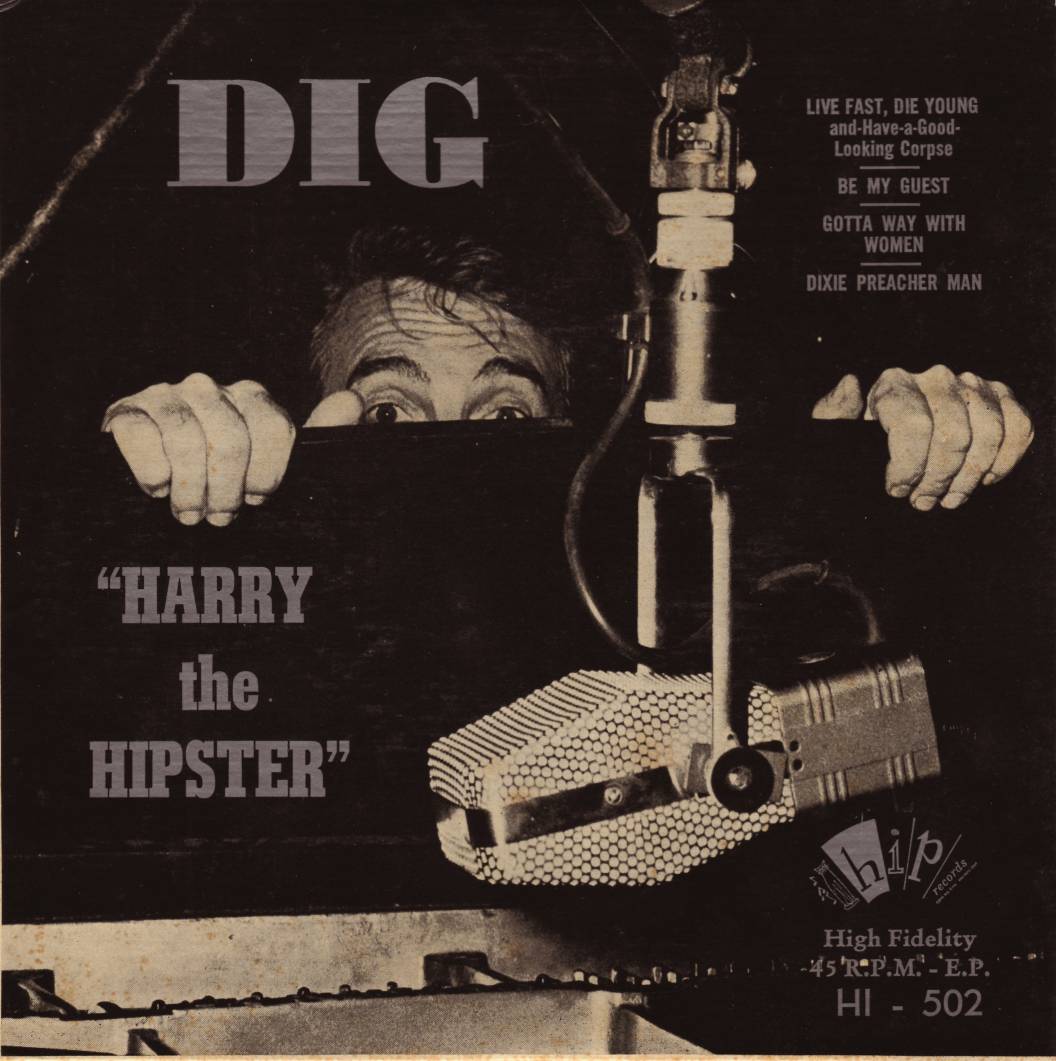





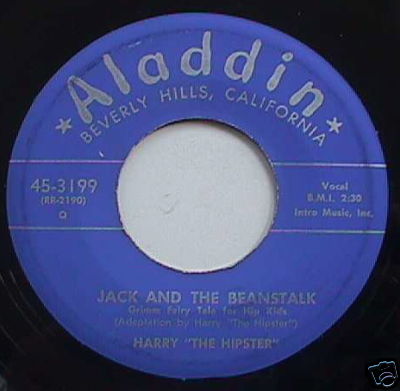

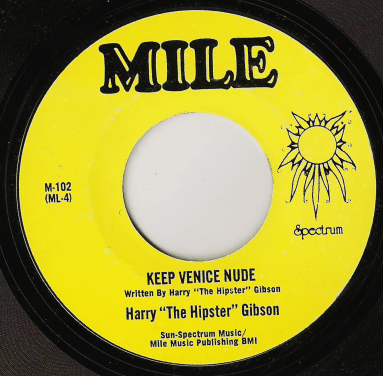
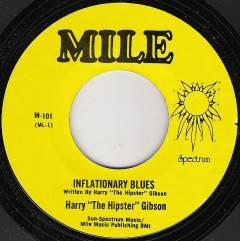
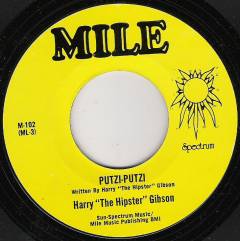
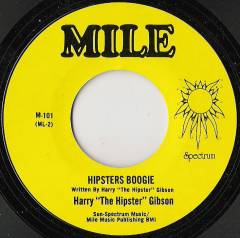

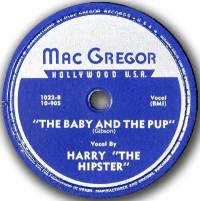
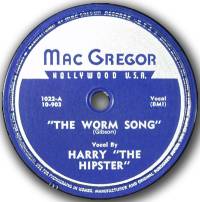
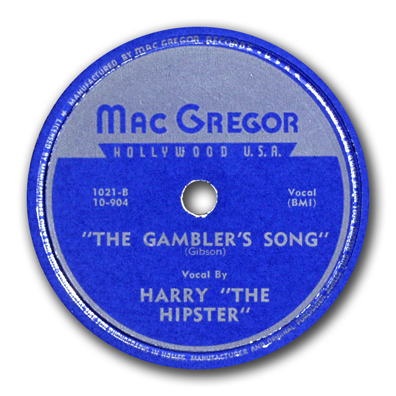
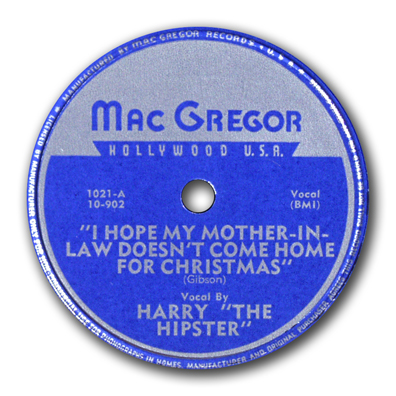
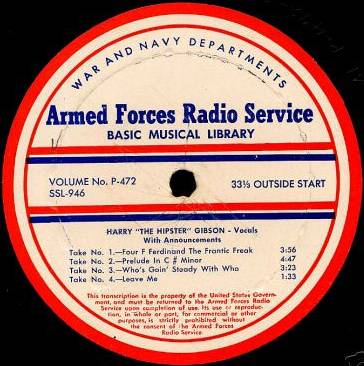
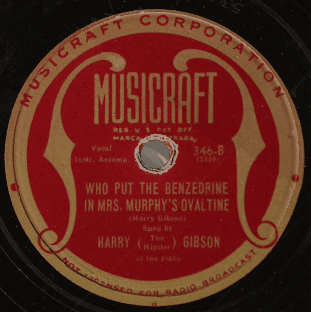
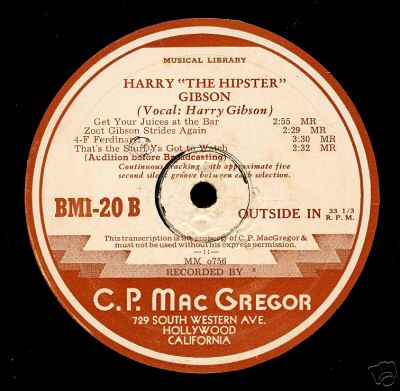
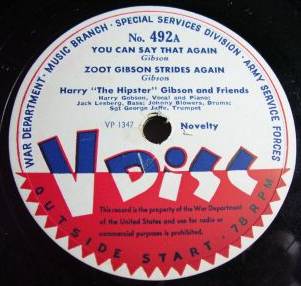

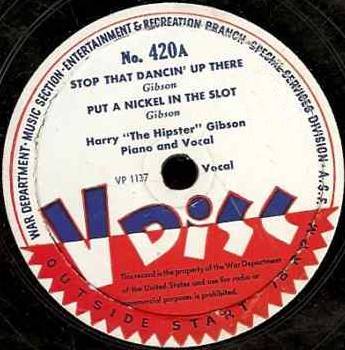
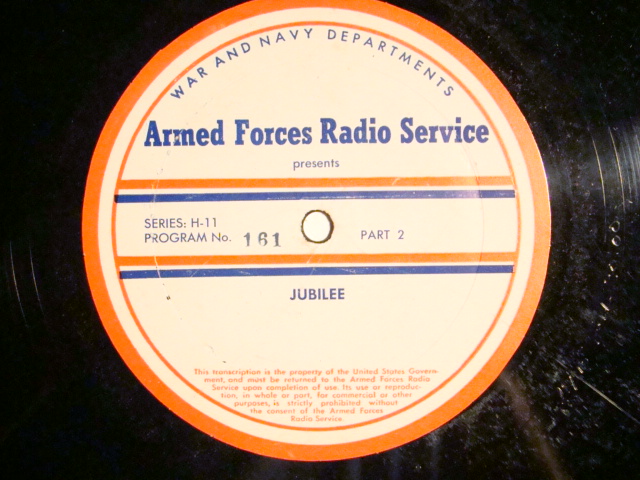
In addition to his records, Harry published some sheet music in
1946, "Sextette for Boogie Woogie."
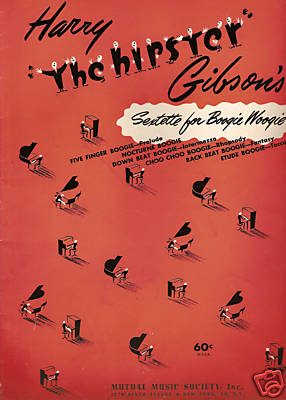
Five Finger Boogie - Prelude
Nocturne Boogie
Down Beat Boogie - Intermezzio
Choo Choo Boogie - Rhapsody
Back Beat Boogie - Fantasy
Etude Boogie - Toccata
Click here for a
pic of Harry's mid-1980's "Blue Fox Jazz Band"
Harry's autobiography
An essay about Harry The Hipster by Richard Marcus
Harry's video reviews by Paghat The
Ratgirl
Essay about Harry by Dan DeMuth
Essay about Harry by Morgan
Wright
Harry was featured in 2009 in
Blues And Rhythm
magazine. Click below.
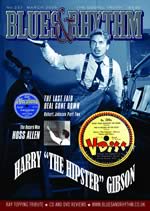
Harry's first magazine cover since 1947!!
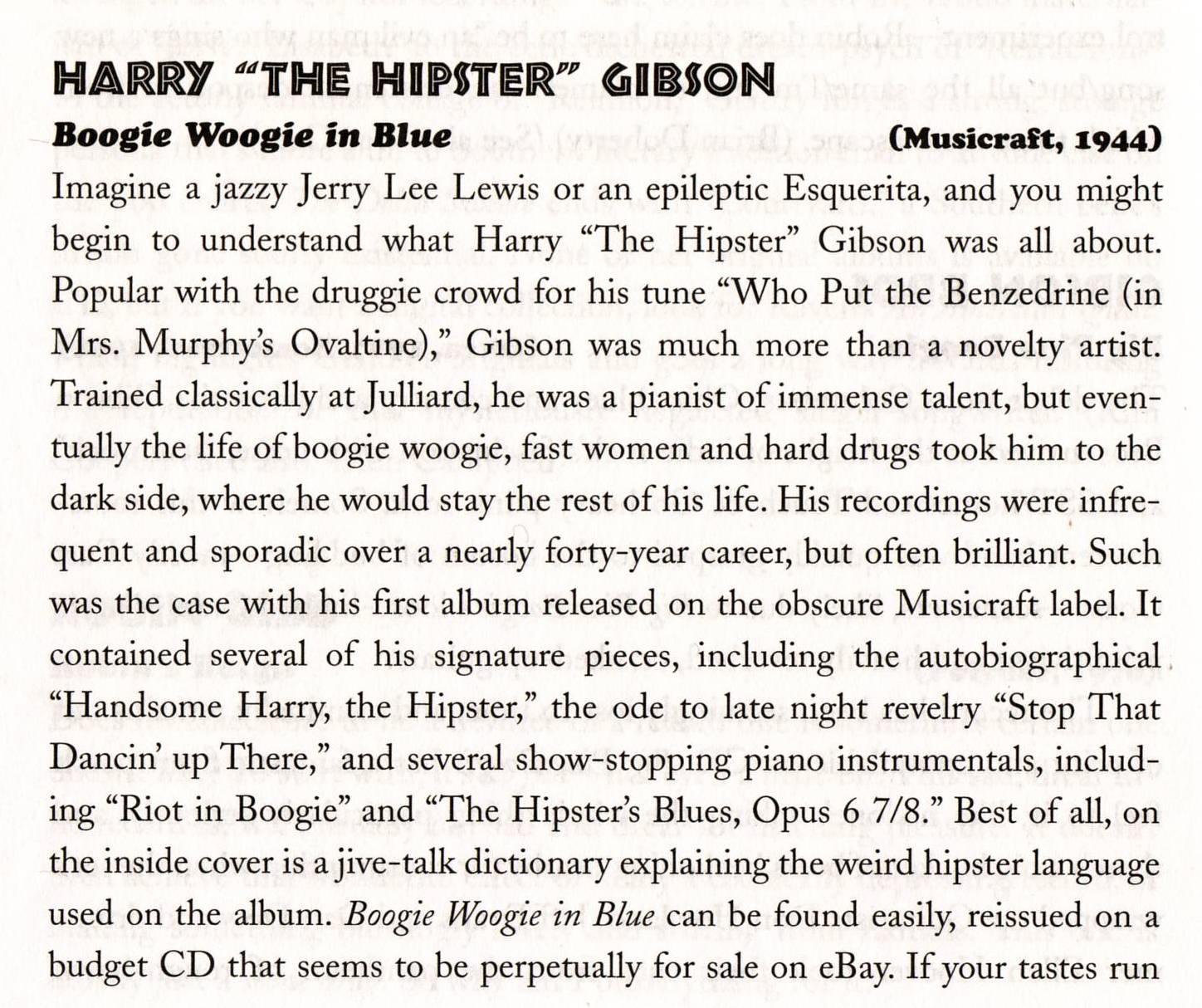

An email from a neighbor
in Florida
Harry has his own myspace page
Contact the Webmaster of this page



































